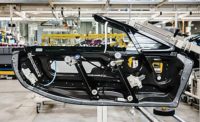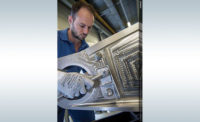The BMW Group has been a pioneer in the field of additive manufacturing.
The company has been using 3D printers since 1991 to produce vehicle components, initially for concept cars, prototypes and race cars, then later for production models. Now, BMW is also making many work aids and tools for its factories using various additive manufacturing processes. These include tailor-made orthoses for employees; teaching and production aids; and large, weight-optimized grippers for robotic handling such things as composite roofs and entire floor assemblies.
BMW’s central hub for production, research and training in additive manufacturing is located in Oberschleißheim, Germany. More than 300,000 parts were “printed” there in 2023. Furthermore, over 100,000 printed parts have been produced per year across all of the plants in BMW’s global production network, from Spartanburg, SC, to Rosslyn, South Africa.
“The increasing use of additive manufacturing in the BMW Group production system has many benefits,” says Jens Ertel, head of additive manufacturing at BMW. “For example, we are able to quickly, economically and flexibly produce our own production aids and handling tools for robots, which we can individually adapt to specific requirements at any time, as well as being able to optimize their weight. Less weight allows higher speeds on the production line, shorter cycle times and reduced costs. Plus, smaller robots can be used in the medium term, which also cuts CO2 emissions and costs.”

Using additive manufacturing to make robotic tooling allows engineers to optimize designs for strength and weight. Photo courtesy BMW
Additive Manufacturing for Molds
In addition to making parts directly with additive manufacturing, BMW is using the technology to create molds and tooling for making parts. For example, at BMW’s casting plant in Landshut, Germany, a sand-based additive manufacturing process is being used to make molds for cast aluminum parts, such as cylinder heads. Here, sand is repeatedly applied in thin layers and stuck together using binders. This makes it possible to create molds for casting complex structures, which are then filled with liquefied aluminum.
“This technology is typically used to manufacture prototype casts, as well as for the large-scale production of components for high-performance motors. Another very attractive field of application is that of large production aids,” says Klaus Sammer, head of product and process planning for light metal casting at BMW.

This 3D printed gripper is roughly 20 percent lighter than a gripper created using conventional materials and methods. Photo courtesy BMW
Additive Manufacturing for Grippers
BMW’s Lightweight Construction and Technology Center in Landshut created a large robotic gripper using additive manufacturing. Weighing around 120 kilograms, the gripper can be printed in just 22 hours.
The gripper was created to handle the roofs for BMW’s M models. The roofs are made of carbon-fiber reinforced plastic (CFRP). A six-axis robot loads a sheet of CFRP into a press. After the sheet is formed, the gripper is rotated 180 degrees to remove the finished roof.
Compared with conventional grippers, the version manufactured using 3D printing was roughly 20 percent lighter. That extends the operating life of the robot, reduces overall wear and tear on the system, and cuts maintenance intervals. It also reduces cycle time.
Uniquely, the gripper was made using two additive manufacturing processes. The gripper’s vacuum cups and clamps are made using selective laser sintering (SLS). The shell and bearing structure are made using large-scale printing (LSP).

BMW’s central hub for production, research and training in additive manufacturing is located in Oberschleißheim, Germany.Photo courtesy BMW
LSP can be used to produce large components economically and sustainably. The process can use virgin plastic granules, as well as recycled plastic and recycled CFRP. Making the gripper using additive manufacturing and recycled material reduces CO2 emissions by 60 percent compared with making the component with virgin material and standard molding processes.
Last year, BMW engineers unveiled a newer, lighter version of the gripper. To achieve this, the previous gripper concept was analyzed and optimized topologically. The new gripper consists of a shell made with an LSP printer, vacuum cups made via SLS, and an optimized bearing structure made from cast aluminum. The mold for the aluminum structure was, of course, produced via additive manufacturing.
The new gripper is 25 percent lighter than its predecessor. As a result, the entire process of manufacturing the CFRP roof of the BMW M3 can be performed with just one robot, rather than three as was previously the case. Now, 3D-printed tooling is uses to handle all the CFRP roofs produced at the Landshut plant.
BMW also employs 3D-printed grippers in chassis construction. For example, grippers printed with the LSP process are used for handling doors at BMW’s assembly plant in Regensburg, Germany.
“With an optimized bearing structure produced using 3D printing, we were able to increase the rigidity of the gripper when handling door elements, while at the same time reducing weight,” says Florian Riebel, head of door and flap production in Regensburg. “In subsequent projects, it is then possible to use robots with a low bearing capacity, which helps to cut costs.”
The automaker is taking the concept one step further at its assembly plant in Munich. Here, a 3D-printed gripper is used to handle the entire floor assembly of the BMW i4 electric vehicle. For this gripper, 3D printing is used to create a sand-casting mold, which is filled with liquid aluminum. The bearing elements were optimized for weight and maximum load capacity. Even with all its add-on elements, the gripper weighs just 110 kilograms. That makes it roughly 30 percent lighter than the previous model, produced using conventional manufacturing methods.

Lighter weight tooling enables BMW to use smaller robots for handling components, which saves energy and reduces carbon emissions. Photo courtesy BMW
Manufacturing the gripper using sand casting and aluminum makes it possible to create intricate, load-optimized structures. This results in maximum weight reduction and thus makes it possible to use smaller handling robots, which require less energy and thus reduce CO2 emissions.
“At the Munich plant, we are continuously expanding the use of production aids created through additive manufacturing,” says Markus Lehmann, head of plant engineering and robotics at the Munich plant. “When it comes to the field of gripper and handling systems, we use 3D printing to equip our established grippers with customized attachments, and we are replacing complete gripper systems with highly integrated and weight-optimized bearing structures.”
Software Aids Design
Lightweight, intricate structures are designed using generative design software tools, such as Synera. BMW iVentures had strategically invested in this software, previously known as Elise. Synera allows fast and efficient optimization of designs and is now used in many development areas within the BMW Group.
The software is particularly beneficial for designing components to be produced using additive manufacturing processes. Topologically optimized, bionic structure designs easily be created thanks to the high degree of flexibility of the additive manufacturing process. This makes it possible to exploit the full potential for lightweight construction.
The BMW Group’s Additive Manufacturing Campus is home to a team of design and construction specialists who use a variety of software to design components. This knowledge is then passed on throughout the company. In the case of gripper design, special workflows have been implemented so that structure design can largely be automated.
ASSEMBLY ONLINE
For more information on robotic tooling, read these articles:
Frame-based Robotic Tooling
Additive Manufacturing and End Of Arm Tooling
AI-Enhanced Robots Improve Aircraft Production


.jpg?height=300&t=1725544628&width=300)


